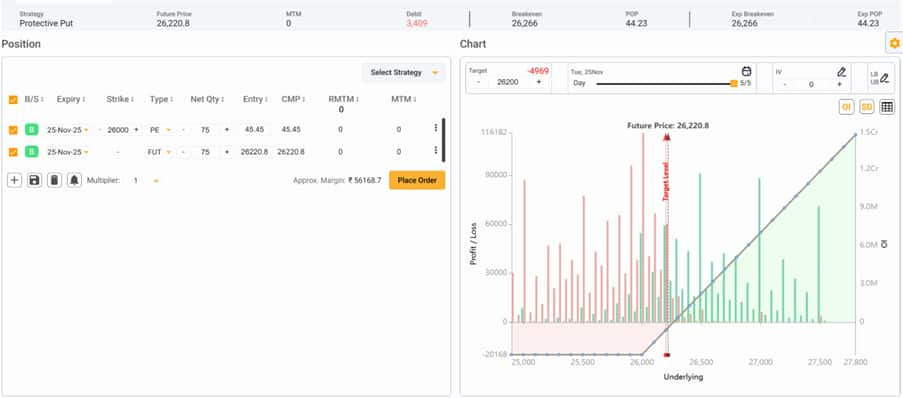Do you ‘Fear’ entering markets post Budget? Use option strategies to make money
"Greed & Fear are the emotions which override rational thinking and today we’ll learn about how to get rid of one of them called ‘Fear’. Correction in a bull market is what everyone ‘desires’ to buy but most investors miss on the opportunity and end up waiting for a better price or they buy too early and lose," says Shubham Agarwal of Quantsapp Private Limited.
SHUBHAM AGARWAL | 03-Feb-18
Reading Time: 3 minutes

Creating a good ‘Forecast’ on the market and ‘Executing’ it is two completely different ball games. Human emotion is what majorly drives the Profit & Loss of an investor more than the core analysis.
Greed & Fear are the emotions that override rational thinking and today we’ll learn about how to get rid of one of them called ‘Fear’.
Correction in a bull market is what everyone ‘desires’ to buy but most investors miss on the opportunity and end up waiting for a better price or they buy too early and lose.
So what’s the way out? Let’s look at a couple of scenarios and see how Options can help.
Want to buy now but have a fear of a further correction?
If you are convinced that the current market price of the stock is a fair price to enter into but afraid of any further downside, the best way out is to buy a Long Call . Let’s look at an example.
Stock A is quoting at Rs 1000 and you feel it is a fair price. Assume we Buy a 1000 strike CE which is quoting at Rs. 20 and has 30 days to expiry. We also believe that within 30 days market should react completely to the Budget announcements. After 30 days we may have the following possible causes.
Case A: Instrument corrects even further to Rs 900
The call option loses 100 percent of its value but the maximum loss we incurred is Rs 20 instead of Rs.100 which would have been the case in buying the stock outright.
Now the same position can be built at a net cost of Rs 920 (Rs 900 of stock value and Rs 20 Loss on CE option) which is still cheaper than Rs 1000.
Case B: Instrument recovers to Rs 1100
The call option , in this case, will expire at Rs 100 yielding a profit of Rs 80. On expiry, we can buy the underlying in cash to then retain the position. The net cost of purchase is Rs 1020 (Rs 1100 stock value – Rs 80 profit on CE).
It is a bit expensive but please remember; it was the one which gave you comfort to buy in the falling market and it deserves the premium.
Want to buy at an even lower price which may or may not be available?
Notional losses are equally painful and the regret of missing a stock remains if you were confident of buying one but, your price never quoted in the market as the best one.
Did you know that you can make returns even with the ‘Intention’ of buying a stock cheaper? Let’s look at an example:
Stock B is quoting at Rs.1000 and you want to buy it at Rs 950. We take a sell trade on 950 strike PE which is quoting at Rs 15 with 30 days to expiry in which you believe the budget effect will neutralize.
Case A: Stock does not test Rs 950 and moves higher to Rs 1050
With our original intention of buying the stock at Rs 950, we would have made zero profits (as no trade was initiated) but post selling put option which now expires worthless, the premium of Rs 15 is your profit from just having an intention to buy the stock lower.
Case B: Stock does come down even further to Rs 900
Had we bought the stock at Rs 950 the loss would have been Rs 50 but adjusting for the sold put premium the loss reduces by Rs 15 and the net price of buy is now Rs 935.
So writing a put option with an intention to buy the stock lower creates a win-win situation.
Important note: Selling a put option without an intention of buying the stock could be risky and the loss is theoretically as much as the stock price.
Learn and read more about option chain from Quantsapp classroom which has been curated for understanding of options and intrinsic value from scratch, to enable option traders grasp the concepts practically and apply them in a data-driven trading approach.
Recent Articles

Evolve Your Trade: The missing step in most trading systems: Shubham Agarwal
06-Dec-25

Best trending option trading strategies: Shubham Agarwal
29-Nov-25

3 best ways to hedge using Options: Shubham Agarwal!
22-Nov-25

When in doubt to write, do Iron Fly: Shubham Agarwal!
15-Nov-25

Identify potential turning points with advance-decline: Shubham Agarwal
08-Nov-25

Slow and spreads more efficient: Shubham Agarwal
01-Nov-25

Use implied volatility as probable top finder: Shubham Agarwal
25-Oct-25

How to trade potential breakout post consolidation: Shubham Agarwal!
18-Oct-25

SHUBHAM AGARWAL is a CEO & Head of Research at Quantsapp Pvt. Ltd. He has been into many major kinds of market research and has been a programmer himself in Tens of programming languages. Earlier to the current position, Shubham has served for Motilal Oswal as Head of Quantitative, Technical & Derivatives Research and as a Technical Analyst at JM Financial.
Recent Articles

Evolve Your Trade: The missing step in most trading systems: Shubham Agarwal
06-Dec-25 20:43:00

Best trending option trading strategies: Shubham Agarwal
29-Nov-25 09:32:00

3 best ways to hedge using Options: Shubham Agarwal!
22-Nov-25 09:11:00

When in doubt to write, do Iron Fly: Shubham Agarwal!
15-Nov-25 10:48:00

Identify potential turning points with advance-decline: Shubham Agarwal
08-Nov-25 10:35:00

Slow and spreads more efficient: Shubham Agarwal
01-Nov-25 10:35:00

Use implied volatility as probable top finder: Shubham Agarwal
25-Oct-25 09:56:00











